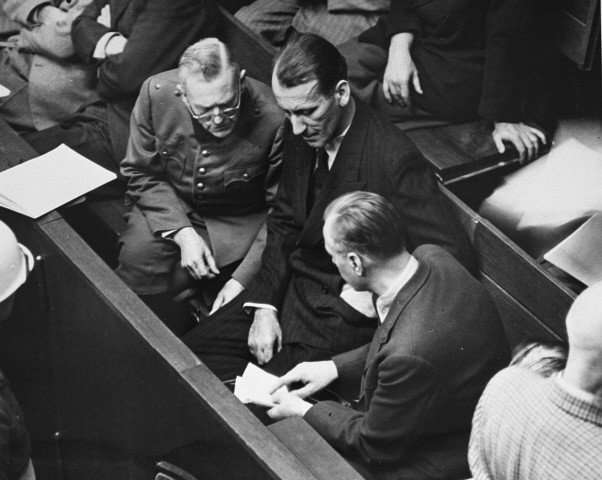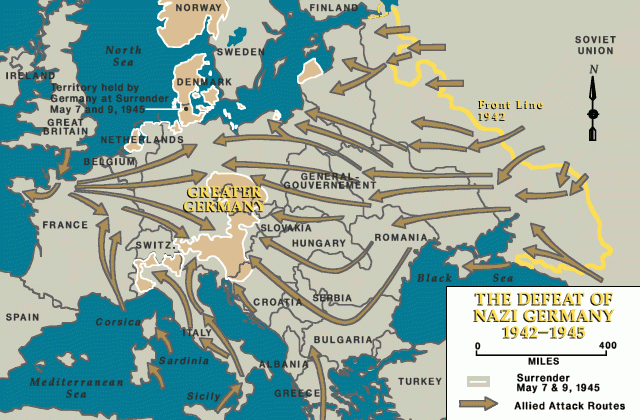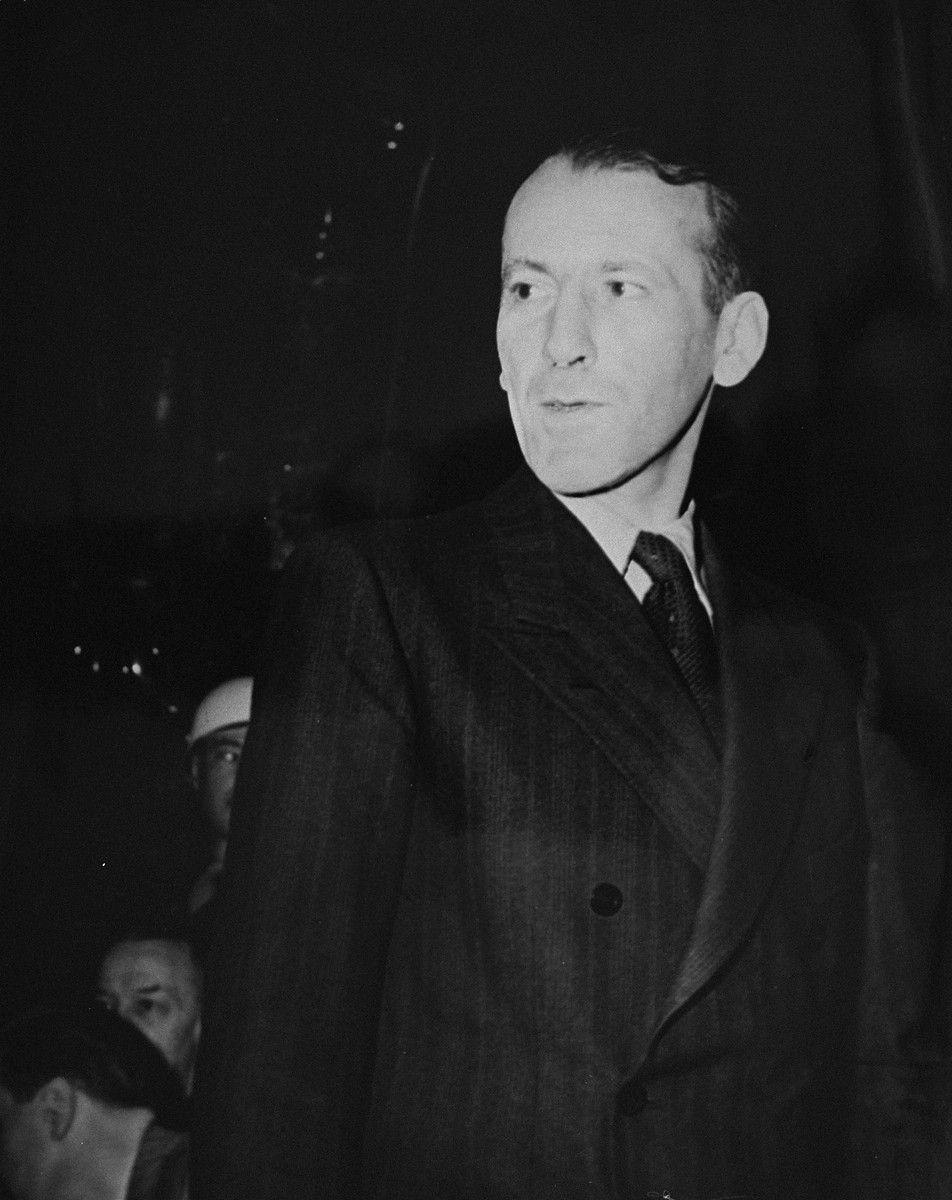
SS: Decline, Disintegration, and Trials

Even at the height of its power and influence in 1942–1944, the SS was not all-powerful inside Nazi Germany. In the occupied territories, the SS encroached upon the jurisdiction of the civilian authorities and even the Wehrmacht. However, as the invading Allied armies and Allied bombings from the air brought the war home to Germany in 1943–1944, the SS was challenged by two powerful rivals.
The Nazi Party apparatus under the Chief of the Party Chancellery, Martin Bormann, was one of those rivals. The power of the party bureaucracy was anchored in the Party District Leaders (Gauleiter) who also had state authority in their positions as Reich Defense Commissars and could mobilize the German population for the final struggle. Hence the party could control the ever-lessening stream of man- and woman-power into military, police, and auxiliary functions in the last year of the war. Moreover, in his second function as the Secretary of the Führer, Bormann controlled access to Hitler, whose health and connection with real events declined precipitously after the July 20, 1944, assassination attempt, and played an ever greater role in translating the Führer's statements into orders for implementation.
Despite postwar disclaimers of powerlessness against SS infiltration, Albert Speer, the Reich Minister of Armaments and War Production, also enjoyed good access to Hitler. Speer had control over the allocation of raw materials, construction resources, and the engineering corps of the state, whose significance increased in proportion to the level of destruction that Allied bombing wrought in the Reich.
The SS began to disintegrate in 1945. Individual SS officers hoped to exploit tensions between the western Allies and the Soviet Union to open negotiations for a separate peace with the western Allies that would permit the Nazi state to survive and fight on against the USSR. These officers included
- SS General Karl Wolff—the Highest SS and Police Leader for German-occupied Italy
- SS General Ernst Kaltenbrunner, Heydrich's successor as chief of the RSHA
- SS General Walter Schellenberg, the chief of the RSHA Department VI (SD Foreign Intelligence Agency)
- and even Himmler himself
Facing unyielding demands for unconditional surrender, the SS men who sent out feelers, lacked the authority—or the conception of themselves in a post-Nazi state—to offer unconditional surrender even to the western Allies.
Wolff succeeded in persuading German military authorities in Northern Italy to surrender to the Anglo-Americans on May 2, 1945, five days before the end of the war. In late April, Himmler himself made an offer of unconditional surrender through an intermediary to General Dwight D. Eisenhower, the Commander-in-Chief of the UK, and US forces in Europe. Hitler heard of the offer by radio on April 29, 1945; in one of his last official acts, the Nazi Führer dismissed Himmler from all of his offices and positions.
Despite these musings about a separate peace at the highest levels, the SS continued to eliminate enemies of the regime, even as the Nazi German state lurched towards collapse in the winter of 1944–1945. Of the 1.2 million prisoners who died in the concentration camps (excluding some 865,000 Jews sent directly to the gas chambers at Auschwitz-Birkenau), around 350,000 reportedly died in the last five months of the war, almost 30%. Most succumbed to the consequences of SS criminal neglect: starvation, exposure, and disease. Moreover, the SS camp staff and guards shot, hanged, or otherwise killed thousands of prisoners in the last months of the war.
On orders from Himmler not to permit concentration camp prisoners to fall alive into enemy hands, the SS guards forced tens of thousands of prisoners on the road, often in bitter winter weather, as the Allied and Soviet advances forced the evacuation of concentration camps. German authorities transported prisoners by truck, open railcar, and on foot to camps located in the interior of the Reich. Remembered by the prisoners as “death marches” because of the high mortality rates and the brutality of the SS guards in shooting prisoners along the way, these evacuations continued until the very end of the war, contributing significantly to the dreadful death toll.
Nor were the inmates of Gestapo and Kripo prisons spared. As Soviet troops overran German positions in the Soviet Union, Poland, and the Reich itself, Security Police officials often slaughtered the remaining prisoners—Jews and non-Jews—before moving west themselves. Often the result of local initiative driven by racial hatred, revenge, or fear, such massacres continued until the last days of the war. There are insufficient records to fully document these killings or to even attempt an estimate of total numbers of victims.
SS Members after World War II
On May 6, 1945, Hitler's successor, Reich President and Admiral Karl Dönitz, formally relieved Himmler of his duties, in accordance with Hitler's orders. Despite his promise to all SS men that he would assume full responsibility for their actions, the former SS chief intended to disappear, donning the uniform of a Secret Field Police and carrying papers in name of Heinrich Hitzinger. On May 20, Soviet troops captured “Hitzinger” and turned him over to the British, to whom Himmler confessed his identity. As his captors attempted a body search, Himmler committed suicide by biting down on a cyanide capsule.
Several other top SS leaders followed Himmler's example, including Odilo Globocnik, the mastermind of Operation Reinhard. Others disappeared into Soviet captivity, or into assumed identities in occupied Germany, or by emigrating to the Americas. Adolf Eichmann, who coordinated the deportation of the central and west European Jews to the east for the RSHA, emigrated under false papers to Argentina after the war. Allied authorities sent some SS leaders back to the scenes of their crimes to stand trial and, after conviction, to face execution, as in the case of Rudolf Höss, the commandant of Auschwitz, who was prosecuted and executed in Poland. In awareness of SS criminal activity, Allied commanders subjected all SS personnel in occupied Germany to automatic arrest.

With Himmler and Heydrich dead, the victorious Allies selected Ernst Kaltenbrunner, Heydrich's successor as chief of the RSHA, to represent the SS and all of its crimes at the trial of the major war criminals in Nuremberg, which opened in November 1945. The tribunal prosecutors also indicted and convicted the SS and the Gestapo-SD collectively as criminal organizations. Leaders of three key SS organizations—the concentration camp administration, the Einsatzgruppen, and the Himmler's Reich Commissariat for Strengthening German Racial Stock—were tried in three subsequent Nuremberg trials under the auspices of the International Military Tribunal.
Each of the victorious Allied powers and each of the governments reconstituted after liberation from German occupation tried hundreds of mid-level and lower-level SS officials. Though members of the SS continued to stand in defendant's docks in the Federal Republic of Germany and elsewhere after the end of World War II—even up to the present day—the vast majority of SS and police were never called to account for their crimes.
Critical Thinking Questions
In what ways did the SS coordinate the activities of German and foreign police agencies to promote the systematic persecution and mass murder of Europe's Jews?
In what ways did the SS coordinate the activities of German and foreign police agencies to persecute perceived "enemies of the state"?
Is it ever too late for accountability?

